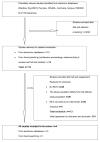Efficacy of motor imagery in post-stroke rehabilitation: a systematic review
- PMID: 18341687
- PMCID: PMC2279137
- DOI: 10.1186/1743-0003-5-8
Efficacy of motor imagery in post-stroke rehabilitation: a systematic review
Abstract
Background: Evaluation of how Motor Imagery and conventional therapy (physiotherapy or occupational therapy) compare to conventional therapy only in their effects on clinically relevant outcomes during rehabilitation of persons with stroke.
Design: Systematic review of the literature
Methods: We conducted an electronic database search in seven databases in August 2005 and also hand-searched the bibliographies of studies that we selected for the review. Two reviewers independently screened and selected all randomized controlled trials that compare the effects of conventional therapy plus Motor Imagery to those of only conventional therapy on stroke patients. The outcome measurements were: Fugl-Meyer Stroke Assessment upper extremity score (66 points) and Action Research Arm Test upper extremity score (57 points). Due to the high variability in the outcomes, we could not pool the data statistically.
Results: We identified four randomized controlled trials from Asia and North America. The quality of the included studies was poor to moderate. Two different Motor imagery techniques were used (three studies used audiotapes and one study had occupational therapists apply the intervention). Two studies found significant effects of Motor Imagery in the Fugl-Meyer Stroke Assessment: Differences between groups amounted to 11.0 (1.0 to 21.0) and 3.2 (-4 to 10.3) respectively and in the Action Research Arm Test 6.1 (-6.2 to 18.4) and 15.8 (0.5 to 31.0) respectively. One study did not find a significant effect in the Fugl-Meyer Stroke Assessment and Color trail Test (p = 0.28) but in the task-related outcomes (p > 0.001).
Conclusion: Current evidence suggests that Motor imagery provides additional benefits to conventional physiotherapy or occupational therapy. However, larger and methodologically sounder studies should be conducted to assess the benefits of Motor imagery.
Figures
References
-
- World OH. The Atlas of Heart Disease and Stroke
Publication types
MeSH terms
LinkOut - more resources
Full Text Sources
Medical



